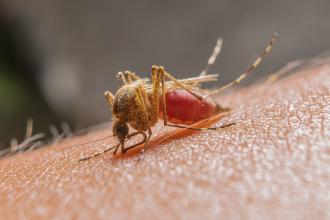Prevention of bites is key to summer safety in BC
As summer arrives many of our patients will be spending time outdoors with their family, friends, and pets. This is an important opportunity to review measures they can take to reduce the risk of illnesses spread by mosquitoes and ticks. The most important vectorborne illnesses to consider in BC are West Nile virus (WNV) spread by mosquitoes and Lyme disease (LD) transmitted by the bite of an infected tick.
While we have not had WNV activity in BC, it has caused illness in neighboring states and provinces in the past year. Washington State had three human cases in 2006; the first in that state. Idaho had a large outbreak of WNV with 996 human cases and 21 deaths related to WNV infection. In 2006 there were 4268 human cases (177 deaths) of WNV reported in the United States and 151 in Canada. A third of cases suffered from West Nile neurological syndrome (WNNS), indicating the heavy burden of the disease on the health care system and the long-term impact. Most cases in Canada were from Ontario (41) and Manitoba (50), but Alberta had its highest number yet with 24 cases reported. While BC has remained free of WNV activity, surveillance data—including climate, vector mosquito, population data, and the presence of avian amplifiers—suggest once WNV is introduced into BC it is likely to become endemic as in other areas of North America. Experience has shown the first year of activity in an area leads to the largest outbreaks of human illness. Ongoing intensive surveillance and efforts such as larviciding are being undertaken in the higher-risk areas to help mitigate any outbreak.
Borrelia burgdorferi (Bb), the spirochete that causes LD, is present at low levels in ticks in BC, and every year three to five cases of LD are diagnosed in people who have been bitten by ticks. The primary vector in BC, Ixodes pacificus, is found in much of the Lower Mainland, Gulf Islands, and Vancouver Island, but is not as competent a vector as Ixodes scapularis, the tick that carries LD in most of eastern and central North America. Research in BC has found Bb in less than 1% of I. pacificus, but even with this low level there is a risk to humans and prevention of tick bites is important.
Preventing tick and mosquito bites
• Walk on cleared trails wherever possible when in tall grass or woods.
• Wear long sleeved, light-colored clothing, and tuck your pants into your boots or socks.
• Use an insect repellent containing DEET.
• Check clothing and scalp when leaving an area where ticks may live. Have someone help you check hard-to-see areas. When a tick is located, remove it immediately.
• Regularly check household pets for ticks.
• Clean up any standing water (mosquito breeding sites) around your home.
• If you live in an area with high numbers of mosquitoes, use mosquito nets/screens or avoid going out when mosquitoes are most active (between dusk and dawn).
All samples should be sent to BCCDC-Laboratory Services and should include the patient’s date of onset of illness and any history of travel on the requisition.
Reporting to public health
Both WNV and Lyme disease are reportable in BC, and both clinical and lab-confirmed cases (see the Table) must be reported to your local medical health officer (MHO). A more detailed investigation of cases will be undertaken by public health to increase understanding of the clinical picture and epidemiology in BC.
For updated information on LD and WNV and ongoing surveillance results, please visit the BCCDC web site at www.bccdc.org.
Table. Laboratory testing of clinical samples for WNV and Lyme Disease
| Sample | BCCDC requisition number | |
| Acute serum on presentation (WNV) or 7 days after tick bite (LD) convalescent serum 10 days later. | Serum (7–10 mL) collected in a gold top serum separator tube | 1806 |
| Acute plasma (WNV) | Plasma (7–10 mL) collected in a purple-top EDTA tube | 1806 |
| Cerebrospinal fluid (WNV) | CSF: 1–2 mL collected in each of two tubes without preservatives. These samples should be kept at 4ºC or frozen for transport | 181 |
—Bonnie Henry MD, MPH, FRCPC
—Muhammad Morshed, PhD, SCCM
BC Centre for Disease Control

